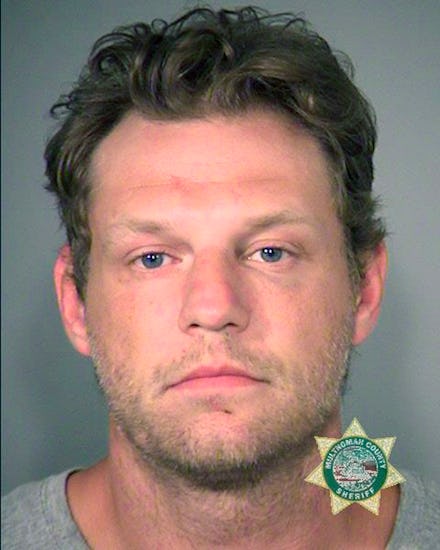Prosecutors assert black teen Larnell Bruce's death was yet another U.S. hate crime

Last month, prosecutors in Multnomah County, Oregon, charged Russel Courtier and his girlfriend, Colleen Hunt, with murder in the death of Larnell Malik Bruce, a 19-year-old black man.
Now they intend to prove that the Aug. 10 dispute between reputed white supremacist Courtier and Bruce, which ended with the young man being mowed down with an SUV outside of a convenience store, was motivated by the couple's anti-black hatred.
If prosecutors are successful, the case will serve as yet another example of a racially motivated attack in the U.S., a statistic in which black people consistently make up the majority of victims in cases reported to the FBI. Yes — even in 2016, anti-black hate violence is still a thing in the U.S.
African-Americans, who make up approximately 13% of the U.S. population of 324 million, are the second largest racial group in the nation. But they made up 62.7% of 3,227 recorded victims who were targeted because of their race, according to FBI statistics from 2014. (2015's statistics have yet to be released by the bureau.)
Bruce, a resident of Vancouver, Washington, initially encountered Courtier around 11:45 p.m. outside of a 7-Eleven convenience store in Gresham, Oregon — about 15 miles east of Portland. Courtier and Bruce, who did not know each other, reportedly fought verbally and physically outside the store before the black teen fled the scene on foot, police said. Courtier reportedly returned to his 1991 red Jeep Wrangler, in which Hunt was waiting in the passenger seat.
According to Courtier and Hunt's indictment documents, the couple intentionally pursued and harmed Bruce, who was still on foot, because of his race or color. Courtier allegedly ran over Bruce, as Hunt encouraged him, saying, "Get him baby, get him."
While it was not immediately clear how else officials were able to establish a racial bias motivation, the allegations were undoubtedly influenced by detectives' knowledge of Courtier's reported membership with the European Kindred white supremacist group. Prosecutors in three separate Oregon counties have brought several violent crime cases against Courtier since 1997, KOIN-TV reported.
EK is a known white supremacist prison gang in Western Oregon. According to the Southern Poverty Law Center, in 2010, the gang had at least 300 confirmed members in the Oregon prison system, about 100-125 members on Portland streets and some chapters in other states in the Western U.S. Members often identify themselves with "EK" tattoos, which Courtier had in Facebook photos obtained by Gresham police.
Authorities found Bruce alive, bleeding from his head and ears, KOIN-TV reported. He suffered traumatic brain injuries and died three days later. Bruce's family and community remember him as an "active member of the community."
Courtier, 38, and Hunt, 35, were re-indicted Monday on first- and second- degree intimidation, according to media reports. They are charged under an Oregon bias crime statute that outlaws intentional threats or targeting because of a person's perceived race, color, religion, sexual orientation, disability or national origin.
The couple was indicted with murder and "failure to perform duties of a driver to injured persons" on Aug. 18, according to local police officials.
Courtier and Hunt are expected to appear Sept. 20 in a Multnomah County court for arraignment on the bias crime charges, KOIN-TV reported. They have been held without bail, according to the Washington Post.
The circumstances of the couple's alleged crimes have an eerie similarity to a particular case of anti-black violence from the past, one that inspired current federal hate crime legislation. In 2009, President Barack Obama signed the Matthew Shepard and James Byrd Jr. Hate Crime Prevention Act. The law was named in part for James Byrd, the 49-year-old African-American who was tied to a truck by white supremacists in Jasper, Texas, and dragged to his death on June 7, 1998.
The Shepard-Byrd Act expanded existing federal hate crime law to include crimes motivated by a victim's real or perceived gender, sexual orientation, gender identity or disability. The act also directs the FBI to track statistics on those additional categories and authorizes the Department of Justice to investigate or prosecute crimes that state officials choose not to pursue.
At a time when black activists have galvanized the nation around the Black Lives Matter movement's anti-police violence message — and rightly so — it's not clear whether the rate of anti-black hate crimes are seen as an equal threat to African-Americans. The world took notice when Dylann Roof, a professed white nationalist, entered a black church in South Carolina and gunned down nine parishioners in 2015. He has been charged under the federal hate crime law and is expected to face trial in November.
But there are lesser-known acts of violence that would not have been prosecuted as hate crimes — like the brutal attack of a black, gay man in Corpus Christi, Texas, in 2012 — had the feds not stepped in.
One thing is clear: If Courtier and Hunt did in fact feel emboldened to perform the crime they've been accused of — allegedly mowing down Bruce due to his race and drive off, leaving him there to bleed out, all due to his race — then the national conversation about racism needs to expand its focus beyond just the context of law enforcement.